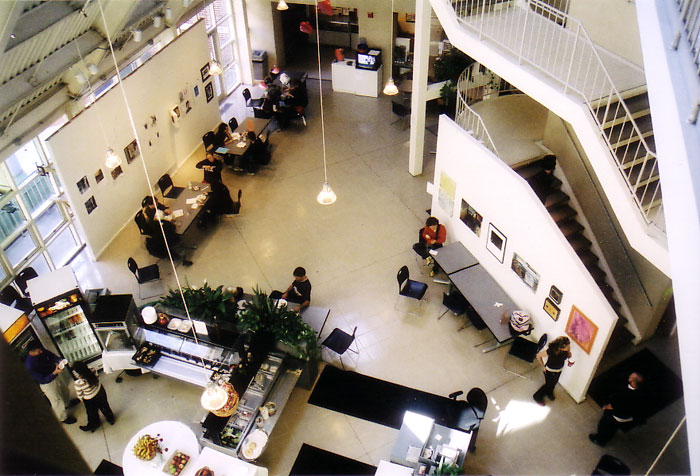
Company/Organization Profiles | Film School & Education | Interviews | Massachusetts | Reports
Film School in New England — What’s the Draw? (Part 2)
Written by Maddy Kadish | Posted by: NewEnglandFilm.com
In part two of a series, NewEnglandFilm.com writer Maddy Kadish investigates the allure of attending film school in New England.
Related article: Film School in New England: What’s the Draw? Part One.
While Emerson College and Boston University get the lion’s share of attention when it comes to film schools in New England, this area is home to numerous others that address film in different ways. After profiling the popular two in Film School in New England – What’s the Draw? (Part 1), NewEnglandFilm.com looks at two very different schools — Fitchburg State University’s film program and the School of the Museum of Fine Arts. What these diverse programs have in common are hard-working and passionate students and faculty. It’s a matter of finding the right fit for you as a filmmaker, or as a Hollywood mogul, or as an artist, or as whatever you want to be.
Fitchburg State University, Film/Video Program
Fitchburg State University offers an undergraduate program in film and video. It is a four-year Bachelor of Science degree in Communication Studies with a concentration in Film and Video. The program is intense, technically oriented, and consists of largely hands-on production work. Through the required production sequence, which is the core of the program, students take eight production courses, plus electives, by the time they graduate, providing multiple opportunities to learn and practice. The program also sponsors VISIONS, an annual juried exhibition of the top-notch student work.
There are currently about 350 students in the concentration and it is one of the more competitive programs at the University. Only those in the program can take film and video classes, students outside the major must apply to enroll.
“It’s the big program you’ve never heard of,” says Zachary Lee, Film/Video Concentration Coordinator and Assistant Professor. “We’re an alternative to the larger film schools in Boston and we’re less than half the costs.” According to US News and World Report, in-state tuition and fees for Fitchburg 2010-2011 are $7,800; out-of-state tuition and fees are $13,880. By contrast, Emerson is $31,272 and BU is $39,864 (also according to US News and World Report).
The concentration’s internship program serves as a springboard for students to connect with the industry post-graduation. It is a mandatory full semester (15 weeks) internship of 37.5 hours of work per week. Students typically complete them in their senior year; but some intern in the summers or tack on an extra semester to accommodate. Students must earn a minimum 2.5 cumulative grade point average to qualify for an internship.
Students always go off campus for their internship — in Boston, New York, or Los Angeles at places such as CNN, ESPN, Arnold Advertising, Miramax Films, and Focus Films. The program ties an internship’s location to GPA as well. The school requires a 3.0 for internships outside New England, and 3.5 for an internship out of the country. “Our students are prepared for the industry. We put them in a great place and then some get hired right out of their internship. I wish I has that as an undergrad,” says Lee of the program.
According to Princeton Review, the total student enrollment for the University is 4,223, mostly from within Massachusetts and some from other parts of New England. It cites the student-to-faculty ratio as 16:1. US News and World Report writes that for fall 2009, Fitchburg State’s acceptance rate is 64 percent.
In addition to his work at Fitchburg, Lee is also a filmmaker with Central Productions, a non-profit that supports local filmmakers and coordinates Open Screen, a monthly “open-mic” night for movies 10 minutes or less, held at the Somerville Theatre. “The film culture is extraordinarily unique here. Intellectually and academically there’s no better place to see films. Boston is very indie-oriented, almost by necessity, but that can be a good thing,” says Lee.
Lee teaches Intermediate and Advanced Film, Cinematography, Lighting, Screenwriting, Sound Design, and Directing. “Students gain a real proficiency here. It’s affordable and close to home for many of our students.”
School of the Museum of Fine Arts
The School of the Museum of Fine Arts (SMFA) attracts more of an arts student to its unique Film and Animation program. The school, in conjunction with Tufts University, offers both undergraduate and graduate degrees for students working towards a Bachelor of Fine Arts, a Master of Fine Arts, a Master of Arts in Teaching in Art Education, or a combined degree. Students take studio classes with SMFA faculty and academic courses with Tufts faculty on site at the SMFA. The non-studio courses are designed for visual thinkers and encourage connections with students’ own art making. The school offers study aboard and internship programs. It focuses on students’ interdisciplinary, self-directed, and creative exploration.
There are some required core classes, particularly for film. But essentially students design their own program, under the guidance of a faculty advisor, that best suit their needs and goals. There are no majors and students select courses from a wide array of studio disciplines, including Film and Animation, Ceramics, Drawing, Glass, Metals, Painting, Photography, Sculpture, and Video. “Our students are interdisciplinary and develop an awareness of visualization — something aside from the film itself — a sculpture that will move through film, for example. They are open and hungry. They are interested in everything,” says Abigail Child, Faculty and the Area Representative of Film and Animation.
The core of the film program is structured around three production classes, which focus on technical aspects, as well as basic theory and lecture. In Film 1 and 2 students complete independent projects, involving single-screen and multiple projections. Film 3 focuses more on collaborative work.
SMFA is a small school. “There is a lot of on-on-one. We always look at student work,” says Child. According to the SMFA website, the undergraduate enrollment is 645 and graduates number at 110. Princeton Review cites that 70 percent are out of state and 8 percent are International, with a student-to-faculty ratio of 10:1. US News and World Report ranks it 37 in its 2008 rankings of Fine Arts Schools. SMFA is a private institution and the website identifies annual tuition for undergraduates as $29,540.
The SMFA is also affiliated with the Professional Arts Consortium, an association of six Boston higher education institutions dedicated to the visual and performing arts. Full-time SMFA students can take studio classes for no additional charge at: Berklee College of Music, The Boston Architectural College, The Boston Conservatory, Emerson College, and Massachusetts College of Art and Design.
SMFA’s faculty are all working artists with exhibitions nationally and internationally. Child is a writer and experimental filmmaker who began as a documentarian. “I like the idea of breaking boundaries and forms. Reality is not linear and continuous to a complete conclusion. This realism has been denied in Hollywood. Why do we need these wrapped up narratives? At SMFA, people are open to this concept; we’re artists. I find this delightful — it’s one of the best parts of this place.”
Child’s experimental work often mixes genres explores language, memory, and history. In 2009 she was awarded the Rome Prize, an annual award from the American Academy in Rome to 15 emerging artists and to 15 scholars to study there. Child is the recipient of a Radcliffe Institute Fellowship, a Fulbright Fellowship (Russia), a Guggenheim Foundation Fellowship, and a Ford Media Grant.
“Students look at moving image in society and are doing all kinds of work: installations — film moving through space, animation, one had video projected onto a book,” says Child. “The availability of sculpture, drawing, and other discipline here is integrated into film. It’s the students that thrill us. When your student inspires you — that’s what you want.”
Also see Film School in New England: What’s the Draw? Part One.
Fitchburg State University’s Film/Video Program:
http://www.fsc.edu/acadaff/departments/commedia.cfm
School of the Museum of Fine Arts:
http://www.smfa.edu/
Also see (also see Part 1) of this story. Fitchburg State University’s Film/Video Program: http://www.fsc.edu/acadaff/departments/commedia.cfm School of the Museum of Fine Arts: http://www.smfa.edu/












